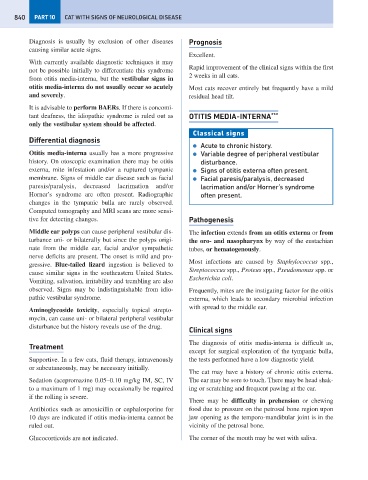Page 848 - Problem-Based Feline Medicine
P. 848
840 PART 10 CAT WITH SIGNS OF NEUROLOGICAL DISEASE
Diagnosis is usually by exclusion of other diseases Prognosis
causing similar acute signs.
Excellent.
With currently available diagnostic techniques it may
Rapid improvement of the clinical signs within the first
not be possible initially to differentiate this syndrome
2 weeks in all cats.
from otitis media-interna, but the vestibular signs in
otitis media-interna do not usually occur so acutely Most cats recover entirely but frequently have a mild
and severely. residual head tilt.
It is advisable to perform BAERs. If there is concomi-
tant deafness, the idiopathic syndrome is ruled out as OTITIS MEDIA-INTERNA ***
only the vestibular system should be affected.
Classical signs
Differential diagnosis
● Acute to chronic history.
Otitis media-interna usually has a more progressive ● Variable degree of peripheral vestibular
history. On otoscopic examination there may be otitis disturbance.
externa, mite infestation and/or a ruptured tympanic ● Signs of otitis externa often present.
membrane. Signs of middle ear disease such as facial ● Facial paresis/paralysis, decreased
paresis/paralysis, decreased lacrimation and/or lacrimation and/or Horner’s syndrome
Horner’s syndrome are often present. Radiographic often present.
changes in the tympanic bulla are rarely observed.
Computed tomography and MRI scans are more sensi-
tive for detecting changes. Pathogenesis
Middle ear polyps can cause peripheral vestibular dis- The infection extends from an otitis externa or from
turbance uni- or bilaterally but since the polyps origi- the oro- and nasopharynx by way of the eustachian
nate from the middle ear, facial and/or sympathetic tubes, or hematogenously.
nerve deficits are present. The onset is mild and pro-
Most infections are caused by Staphylococcus spp.,
gressive. Blue-tailed lizard ingestion is believed to
Streptococcus spp., Proteus spp., Pseudomonas spp. or
cause similar signs in the southeastern United States.
Escherichia coli.
Vomiting, salivation, irritability and trembling are also
observed. Signs may be indistinguishable from idio- Frequently, mites are the instigating factor for the otitis
pathic vestibular syndrome. externa, which leads to secondary microbial infection
with spread to the middle ear.
Aminoglycoside toxicity, especially topical strepto-
mycin, can cause uni- or bilateral peripheral vestibular
disturbance but the history reveals use of the drug.
Clinical signs
The diagnosis of otitis media-interna is difficult as,
Treatment
except for surgical exploration of the tympanic bulla,
Supportive. In a few cats, fluid therapy, intravenously the tests performed have a low diagnostic yield.
or subcutaneously, may be necessary initially.
The cat may have a history of chronic otitis externa.
Sedation (acepromazine 0.05–0.10 mg/kg IM, SC, IV The ear may be sore to touch. There may be head shak-
to a maximum of 1 mg) may occasionally be required ing or scratching and frequent pawing at the ear.
if the rolling is severe.
There may be difficulty in prehension or chewing
Antibiotics such as amoxicillin or cephalosporine for food due to pressure on the petrosal bone region upon
10 days are indicated if otitis media-interna cannot be jaw opening as the temporo-mandibular joint is in the
ruled out. vicinity of the petrosal bone.
Glucocorticoids are not indicated. The corner of the mouth may be wet with saliva.

